哈佛大学:幸福课(全23集,115盘下载)
- 格式:pdf
- 大小:46.27 KB
- 文档页数:2

哈佛积极心理学幸福课【中英文实用版】英文文档:Harvard"s Positive Psychology Course on HappinessHarvard University offers a popular course on positive psychology, which focuses on the study of what makes life worth living.This course delves into the factors that contribute to happiness and well-being, providing valuable insights for students seeking to improve their own lives.The course covers various topics, including the science of happiness, positive emotions, strengths and virtues, relationships, and meaningful activities.Students learn about the latest research in the field of positive psychology and explore practical strategies for enhancing their own well-being.One of the key aspects of the course is its emphasis on self-reflection and personal growth.Students are encouraged to explore their own values and beliefs, and to identify their strengths and areas for improvement.Through assignments and discussions, they develop a deeper understanding of themselves and learn how to apply positive psychology principles to their daily lives.The course also provides practical tools for stress management and resilience, helping students to navigate life"s challenges with greaterease.By the end of the course, students gain a comprehensive understanding of the principles of positive psychology and how to apply them to their own lives to achieve greater happiness and fulfillment.中文文档:哈佛积极心理学幸福课哈佛大学的这门积极心理学课程非常受欢迎,它专注于研究什么让生活更有价值。
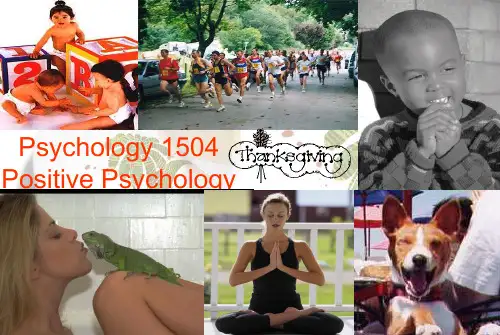
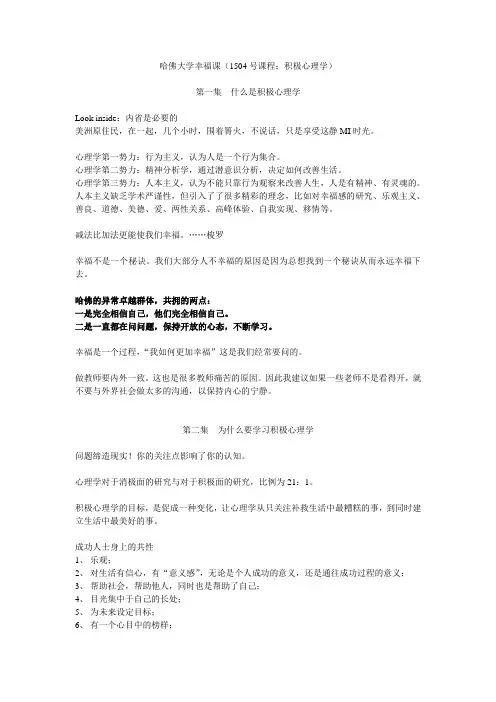
哈佛大学幸福课(1504号课程:积极心理学)第一集什么是积极心理学Look inside:内省是必要的美洲原住民,在一起,几个小时,围着箐火,不说话,只是享受这静MI时光。
心理学第一势力:行为主义,认为人是一个行为集合。
心理学第二势力:精神分析学,通过潜意识分析,决定如何改善生活。
心理学第三势力:人本主义,认为不能只靠行为观察来改善人生,人是有精神、有灵魂的。
人本主义缺乏学术严谨性,但引入了了很多精彩的理念,比如对幸福感的研究、乐观主义、善良、道德、美德、爱、两性关系、高峰体验、自我实现、移情等。
减法比加法更能使我们幸福。
……梭罗幸福不是一个秘诀。
我们大部分人不幸福的原因是因为总想找到一个秘诀从而永远幸福下去。
哈佛的异常卓越群体,共拥的两点:一是完全相信自己,他们完全相信自己。
二是一直都在问问题,保持开放的心态,不断学习。
幸福是一个过程,“我如何更加幸福”这是我们经常要问的。
做教师要内外一致。
这也是很多教师痛苦的原因。
因此我建议如果一些老师不是看得开,就不要与外界社会做太多的沟通,以保持内心的宁静。
第二集为什么要学习积极心理学问题缔造现实!你的关注点影响了你的认知。
心理学对于消极面的研究与对于积极面的研究,比例为21:1。
积极心理学的目标,是促成一种变化,让心理学从只关注补救生活中最糟糕的事,到同时建立生活中最美好的事。
成功人士身上的共性1、乐观;2、对生活有信心,有“意义感”,无论是个人成功的意义,还是通往成功过程的意义;3、帮助社会,帮助他人,同时也是帮助了自己;4、目光集中于自己的长处;5、为未来设定目标;6、有一个心目中的榜样;7、不只依靠自己,寻求社会的支持,并有寻求支持的勇气。
西岸小学Marve Collions(推荐书目:Marve Collions’ way)种子说:种子是有潜力的,它会发芽开花结果,但必须有水的灌溉,有阳光的照耀,除去杂草,悉心照料。
没有人会来!――没有人会穿着闪亮的铠甲把你带到幸福家园。

哈佛幸福课——积极心理学目录第一章积极心理学初探 (1)一.积极心理学诞生的背景 (1)二、积极心理学课程的内容 (3)三.消极研究与积极研究 (6)四、积极心理学课程的目的 (9)第二章积极心理学的五个基本前提 (10)一、搭建学术界与社会之间的桥梁 (10)二、改变是可能的 (11)三、内在因素和外在因素 (12)四、顺从人类本性 (15)五、允许自己追求快乐 (20)第三章信念即自我实现预言 (23)一、信念挑战极限 (23)二、皮革马利翁效应(Pygmalion Effect) (24)三、情境的重要性 (26)四、创造积极的情境——精神的力量 (30)五、精神力量的作用机制 (33)六、乐观主义与悲观主义——同一事件不同解读 (35)七、高期望导致低自尊?NO! (38)八、三个方法让自己更乐观 (40)第四章专注 (44)一、积极者与消极者 (44)二、为什么不是人人都是乐观主义者 (48)三、感激 (50)第五章改变 (62)一、改变不易但非不可能 (63)二、神经可塑性 (65)三、我真的想要改变吗? (68)四、ABC与两种变化 (70)五、日记的神奇作用 (96)六、小结 (102)第六章设定目标 (106)一、目标设定的理论及实践 (106)二、处理压力 (128)第七章完美主义 (139)一、完美主义之我的个人经历 (139)二、错误与失败 (142)三、完美主义的定义及特征 (148)四、完美主义的后果及危害 (151)五、二八法则 (157)六、完美主义的根源 (159)七、克服完美主义 (161)八、铂金法则与黄金法则 (163)九、小结 (165)第八章精神与肉体 (167)一、关注“脖子以下” (167)二、身体锻炼 (169)三、冥想 (176)四、睡眠 (181)五、触摸 (183)第一章积极心理学初探一.积极心理学诞生的背景快乐,幸福感这一整个领域,此前一直被心理自助运动统治。


哈佛幸福课——积极心理学目录第一章积极心理学初探 (1)一.积极心理学诞生的背景 (1)二、积极心理学课程的内容 (3)三.消极研究与积极研究 (6)四、积极心理学课程的目的 (9)第二章积极心理学的五个基本前提 (10)一、搭建学术界与社会之间的桥梁 (10)二、改变是可能的 (11)三、内在因素和外在因素 (12)四、顺从人类本性 (15)五、允许自己追求快乐 (20)第三章信念即自我实现预言 (23)一、信念挑战极限 (23)二、皮革马利翁效应(Pygmalion Effect) (24)三、情境的重要性 (26)四、创造积极的情境——精神的力量 (30)五、精神力量的作用机制 (33)六、乐观主义与悲观主义——同一事件不同解读 (35)七、高期望导致低自尊?NO! (38)八、三个方法让自己更乐观 (40)第四章专注 (44)一、积极者与消极者 (44)二、为什么不是人人都是乐观主义者 (48)三、感激 (50)第五章改变 (62)一、改变不易但非不可能 (63)二、神经可塑性 (65)三、我真的想要改变吗? (68)四、ABC与两种变化 (70)五、日记的神奇作用 (96)六、小结 (102)第六章设定目标 (106)一、目标设定的理论及实践 (106)二、处理压力 (128)第七章完美主义 (139)一、完美主义之我的个人经历 (139)二、错误与失败 (142)三、完美主义的定义及特征 (148)四、完美主义的后果及危害 (151)五、二八法则 (157)六、完美主义的根源 (159)七、克服完美主义 (161)八、铂金法则与黄金法则 (163)九、小结 (165)第八章精神与肉体 (167)一、关注“脖子以下” (167)二、身体锻炼 (169)三、冥想 (176)四、睡眠 (181)五、触摸 (183)第一章积极心理学初探一.积极心理学诞生的背景快乐,幸福感这一整个领域,此前一直被心理自助运动统治。

第一课Hi, good morning. It’s wonderful to be back here.各位,早上好。
很高兴能回到这里。
Wonderful to see you here.高兴见到你们。
I am teaching this class because I wish a class like this had been taught when I was sitting in your seat as an undergraduate here.我教授这门课是因为在我读本科阶段时非常希望能学习这样一门课程。
This does not mean it is a class you wish to be taught nor does it mean that it is the right class for you.可能这门课并不是你希望的那样也可能并不适合你。
But I hope to doing the next couple of lectures is giving you an idea what this class is about so that you can decide whether or not it is for you.但希望几堂课后,你能有个大概印象让你决定这门课程是否适合你。
I came here in 1992 and studied the computer science and concentrator.我1992年来到哈佛求学,一开始主修计算机科学。
And when I had I mini epiphany half way through my sophomore year.大二期间,突然顿悟了。
I realized that I was in a wonderful place with wonderful students around me, wonderful teachers.我意识到我身处让人神往大学校园周围都是出色的同学,优秀的导师。
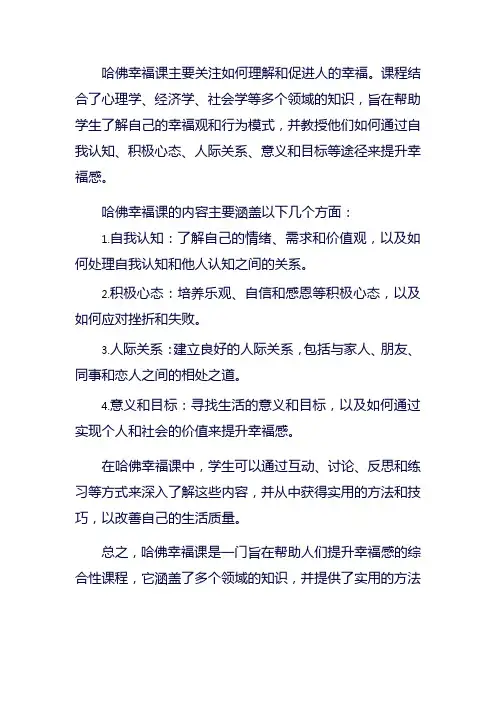
哈佛幸福课主要关注如何理解和促进人的幸福。
课程结合了心理学、经济学、社会学等多个领域的知识,旨在帮助学生了解自己的幸福观和行为模式,并教授他们如何通过自我认知、积极心态、人际关系、意义和目标等途径来提升幸福感。
哈佛幸福课的内容主要涵盖以下几个方面:
1.自我认知:了解自己的情绪、需求和价值观,以及如何处理自我认知和他人认知之间的关系。
2.积极心态:培养乐观、自信和感恩等积极心态,以及如何应对挫折和失败。
3.人际关系:建立良好的人际关系,包括与家人、朋友、同事和恋人之间的相处之道。
4.意义和目标:寻找生活的意义和目标,以及如何通过实现个人和社会的价值来提升幸福感。
在哈佛幸福课中,学生可以通过互动、讨论、反思和练习等方式来深入了解这些内容,并从中获得实用的方法和技巧,以改善自己的生活质量。
总之,哈佛幸福课是一门旨在帮助人们提升幸福感的综合性课程,它涵盖了多个领域的知识,并提供了实用的方法
和技巧。
通过学习这门课程,学生可以更好地了解自己,掌握提升幸福感的途径,并应用到日常生活中。

哈佛⼤学排名第⼀的公开课:幸福课(积极⼼理学)哈佛⼤学排名第⼀的公开课:幸福课(积极⼼理学)哈佛⼤学排名第⼀的公开课:幸福课(积极⼼理学)出⼈意料,从前年开始哈佛⼤学最受欢迎的选修课是“幸福课”,听课⼈数超过了王牌课《经济学导论》。
教这门课的是⼀位名不见经传的年轻讲师,名叫泰勒.本-沙哈尔。
我们来到这个世上,到底追求什么才是最重要的?他坚定地认为:幸福感是衡量⼈⽣的唯⼀标准,是所有⽬标的最终⽬标。
塔尔博⼠在哈佛学⽣中享有很⾼的声誉,受到学⽣们的爱戴与敬仰,被誉为"最受欢迎讲师"和"⼈⽣导师"。
在⼀周两次的“幸福课”上,本-沙哈尔没有⼤讲特讲怎么成功,⽽是深⼊浅出地教他的学⽣,如何更快乐,更充实、更幸福。
⼀、幸福,应该是快乐与意义的结合“⼀个幸福的⼈,必须有⼀个明确的、可以带来快乐和意义的⽬标,然后努⼒地去追求。
真正快乐的⼈,会在⾃⼰觉得有意义的⽣活⽅式⾥,享受它的点点滴滴。
”本-沙哈尔竟然从汉堡⾥,总结出了4种⼈⽣模式。
当年,为了准备重要赛事,除了苦练外,他须严格节制饮⾷。
开赛前⼀个⽉,只能吃最瘦的⾁类,全麦的碳⽔化合物,以及新鲜蔬菜和⽔果。
他曾暗中发誓,⼀旦赛事完了,⼀定要⼤吃两天“垃圾⾷品”。
⽐赛⼀结束,他⼲的第⼀件事,就是奔到⾃⼰喜爱的汉堡店,⼀⼝⽓买下4只汉堡。
当他急不可待地撕开纸包,把汉堡放在嘴边的刹那,却停住了。
因为他意识到,上个⽉,因为健康的饮⾷,⾃⼰体能充沛。
如果享受了眼前汉堡的美味,很可能会后悔,并影响⾃⼰的健康。
望着眼前的汉堡,他突然发现,它们每⼀种都有⾃⼰独特的风味,可以说,代表着4种不同的⼈⽣模式。
第⼀种汉堡,就是他最先抓起的那只,⼝味诱⼈,但却是标准的“垃圾⾷品”。
吃它等于是享受眼前的快乐,但同时也埋下未来的痛苦。
⽤它⽐喻⼈⽣,就是及时享乐,出卖未来幸福的⼈⽣,即“享乐主义型”;第⼆种汉堡,⼝味很差,⾥边全是蔬菜和有机⾷物,吃了可以使⼈⽇后更健康,但会吃得很痛苦。
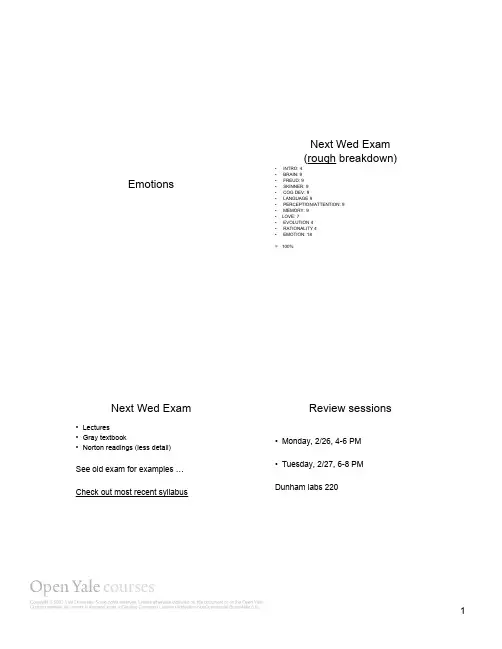
EmotionsNext Wed Exam• Lectures• Gray textbook• Norton readings (less detail)See old exam for examples … Check out most recent syllabusNext Wed Exam(rough breakdown) • INTRO: 4• BRAIN: 9• FREUD: 9• SKINNER: 9• COG DEV: 9• LANGUAGE 9• PERCEPTION/ATTENTION: 9• MEMORY: 9• LOVE: 7• EVOLUTION 4• RATIONALITY 4• EMOTION: 18= 100%Review sessions • Monday, 2/26, 4-6 PM• Tuesday, 2/27, 6-8 PM Dunham labs 220William James on human instincts To the psychologist alone can such questions occur as: Why do we smile, when pleased, and not scowl? Why are we unableto talk to a crowd as we talk to a single friend? Why does a particular maiden turnour wits upside-down? The common mancan only say: "Of course we smile, of course our heart palpitates at the sight ofthe crowd, of course we love the maiden …The wrong theory of emotions William James on human instincts And so, probably, does each animal feelabout the particular things it tends to do inthe presence of certain objects ... To thelion it is the lioness which is made to be loved; to the bear, the she-bear. To the broody hen, the notion would probably seem monstrous that there should be a creature in the world to whom a nestful ofeggs was not the utterly fascinating and precious and never-to-be-too-much-sat-upon object which it is to her ...Life is impossible withoutemotions• Evolved mechanisms that set goalsand priorities• Shaped by cultural context•But universal roots …Outline 1. Facial expressions--The case of smiling2. Non-social emotions--The case of fear3. Feelings toward kin4. Feelings toward non-kinMake a face• Lower your brows and draw themtogether• Tense your lower and upper eyelids • Stare. Your eyes can bulge somewhat • Press your lips together, with thecorners straight or down1. Universal feelings;universal facesMake a face (II)1. Raise the corners of your lips backand up2. Raise your cheeks3.Raise your lower eyelids (if you can)Smiles are universalSmiles are social signals• Bowlers• Olympic gold-medal winnersTwo types of smiles• Happiness smile (Duchenne smile) • “Pan am” smile, or greeting smile-- 10-month-olds-- Happy vs. unhappy couples-- College yearbook photosThere are different types ofsmilesA third smileCoy smiles, Appeasement smiles-entail gaze/face aversion-often with self-touch-in situations with potential fornegative evaluation of self-related to embarrassment-related to a desire to affiliate2. Non-social emotions:The case of fearSocial emotionsAltruism towards kinFearSpiders, snakes, heights, storms, large animals, darkness, blood, strangers, humiliation, deep water, leaving home alone-- what do these have in common? NOT: guns, cars, electrical outletsWhat are non-human primates afraid of? What are children in Chicago afraid of?Are animals merely survivalmachines?• Not according to evolutionary theory• Gene A: makes an animal care for itsoffspring• Gene B: makes an animal care only for itself • Gene A wins•It is reproduction that mattersForget about the animal for amoment …• Take the perspective of the …--cold virus--toxoplasmosis parasite--rabies virus• Animals are the vehicles that these organisms exploit to reproduceTake the perspective of thegene• Which genes survive?• Those that make the most copies of themselves• Animals are “vehicles” through which genes reproduce“An animal is merely the genes’ way of making another gene”Take the perspective of thegeneSelfish genes lead to altruisticanimals• To the extent that evolution operates at the level of the genes, there is no hard-and-fast distinction between oneselfand anotherHaldane’s--“Would you lay down your life for yourbrother?”--“No, but I would gladly give my life forthree brothers, or five nephewfirst cousins”Haldane’s math Haldane’s math--“Would you lay down your life for your --“Would you lay down your life for your brother?” brother?”(who has 50% of your genes) (who has 50% of your genes)--“No, but I would gladly give my life forthree brothers (150%), or five nephews(125%), or nine first cousins (112.5%)Choose:You die or your three brothersdie• Gene A: makes an animal choose to die • Gene B: makes an animal choose forits brothers to die• Gene A winsAnimals have evolved to benice to kin• Particularly their children (50% of genes)• And particularly birds and mammals• Quality, not quantity• Long period of dependence prior to sexual maturity• Two types of psychological mechanisms:--how parents respond to children--how children respond to parents When a new male takesover a pride (by killingor driving out theprevious male) …--he kills all remainingcubs--pregnant lionessesundergo spontaneousabortionsBaby attachment to the parent• The cupboard theory (Skinner)• Innate attachment (Bowlby)--positive: drawn to mom for comfort andsocial interaction--negative: fear of strangersHarlow: Wire mothers vs. cloth mothers。
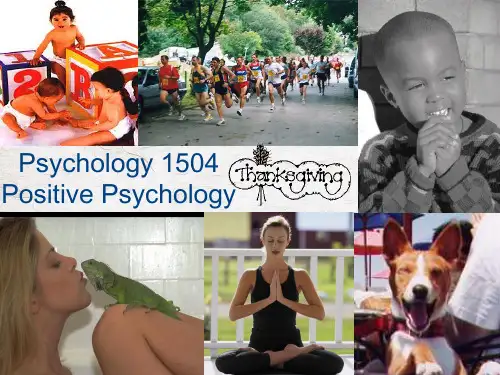
哈佛大学公开课:幸福课~~~睡眠、触摸和爱情的重要性系统性学习某个科目,越往后越难坚持。
很多人自认为之前已经学的差不多了,再往后看看标题大概也就知道什么意思了,没必要非得继续看下去。
有这样想法的人,我估计有很多,包括我在内。
但是,凭借我多年对“系统性突击某领域知识”给我带来的好处,我知道:无论后面知识再怎么水,我都必须要坚持看完,学完。
这,就是我通常形容的对某项知识“地毯式轰炸”,否则你很难了解全貌。
通常情况下,那些仅仅看看标题就自认为了解大概的,往往会经常犯同样的错误:信息传递不够精准,总是让人误会。
比如我和同事的某次对话:…………某天,我和同事一起聊天……我问:“最近看我群聊有什么感受吗?”同事说:“收获特别多,我发现你的聊天内容,已经形成思维定式了……”我说:“这是我最讨厌的一种评价,一旦一个人形成思维定式,想改就很难了……你是不是想说'我发现你的聊天内容,已经形成独特风格了’?”同事说:“就是这个意思,可能是我表达不是很清楚……”我说:“不是不清楚,而是偏差太大。
思维定式通常来讲,是形容固执己见人的,而语言风格显然要比思维定式好很多。
比如毛教员的文章,就有毛风,鲁迅也有鲁风……你能把毛教员和鲁迅的文章也评价为'思维定式’吗?”后来又闲聊了一会儿别的,在谈到某个富豪做生意还在走过度营销策略的时候,同事又有说话了……同事说:“他这种行为应该算是思维定式了吧?”我说:“那叫路径依赖……路径依赖跟思维定式有本质区别,路径依赖听了还有之前人家赚到大钱的信息,而思维定式却没有……”…………大多数人之所以犯类似的错误,就是因为他们在学习某些知识的时候,自认为自己已经知道了,但是一到用的时候,总是出现偏差,归根结底,估计都跟没有系统性学习某项知识有关,所以在借用某项知识的时候,总是太片面看问题……媒体经常干的事儿,就是“掐头去尾”报道新闻,达到新闻信息高点击率的目的。
所以,养成系统性思考问题和系统性学习知识,是非常有必要的。
哈佛大学:幸福课13(1).mp4 /file/e6rtxoa1# 哈佛大学:幸福课22.mp4 /file/e6rtxosv# 哈佛大学:幸福课21.mp4 /file/dn9mu7pm# 哈佛大学:幸福课20.mp4 /file/e6rtxq0b# 哈佛大学:幸福课19.mp4 /file/dn9mu5yc# 哈佛大学:幸福课18.mp4 /file/bh0gvlvl# 哈佛大学:幸福课17.mp4 /file/clo36msl# 哈佛大学:幸福课16.mp4 /file/e6rtxhp1# 哈佛大学:幸福课15.mp4 /file/bh0gv89g# 哈佛大学:幸福课13.mp4 /file/dn9mtmc7# 哈佛大学:幸福课14.mp4 /file/clo350ja# 哈佛大学:幸福课11.mp4 /file/aqaul593# 哈佛大学:幸福课12.mp4 /file/e6rt9g6e# 哈佛大学:幸福课08.mp4 /file/e6rt9acf#
哈佛大学:幸福课09.mp4
哈佛大学:幸福课04.mp4 /file/bh0goy8n# 哈佛大学:幸福课07.mp4 /file/bh0gouxf# 哈佛大学:幸福课06.mp4 /file/dn9mtgkm# 哈佛大学:幸福课05.mp4 /file/bh0go0d2# 哈佛大学:幸福课03.mp4 /file/clo35txn# 哈佛大学:幸福课02.mp4 /file/clo35qv4# 哈佛大学:幸福课01.mp4 /file/clo35gmc# 哈佛大学:幸福课.mp4。